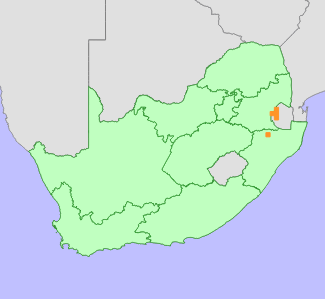|
Scientific Name | Cephalaria foliosa Compton |
Higher Classification | Dicotyledons |
Family | DIPSACACEAE |
National Status |
Status and Criteria | Vulnerable D2 |
Assessment Date | 2006/10/30 |
Assessor(s) | W.G. Welman & J.E. Victor |
Justification | Known from fewer than five locations and potentially threatened by afforestation, agriculture, overgrazing, urban expansion and alien plant invasion. |
Distribution |
Endemism | Not endemic to South Africa |
Provincial distribution | KwaZulu-Natal |
Range | Eastern Swaziland and Vryheid district in northern KwaZulu-Natal. |
Habitat and Ecology |
Major system | Terrestrial |
Major habitats | KaNgwane Montane Grassland, Paulpietersburg Moist Grassland |
Description | Moist montane grassland, in wetlands and near streams, 1000-1500 m. |
Threats |
| Moist montane grasslands in the Vryheid district are extensively transformed by forestry plantations and agriculture (NLC 1996) and are also generally severely overgrazed (I. Johnson pers. comm.). Habitat in Swaziland is also likely to be threatened by forestry plantations (Mankaiana, Mbabane and Forbes Reef), urban expansion (Mbabane), degradation as a result of overgrazing (Mankaiana) and encroaching alien vegetation. Since this species is only known from fairly old herbarium collections (last collected in 1962) and most locality descriptions are fairly vague, it is not known whether threats are currently directly impacting on subpopulations. However, due to the extensive transformation of the habitat it could be suspected that there is likely to be an ongoing decline in the quality and/or extent of the habitat.
There has definitely been extensive habitat loss in the past. However, the ecology of this species is too poorly known to tell whether it is a long-lived resprouter that would qualify for a threatened status under the A criterion due to extensive habitat loss within three generations. |
Population |
Population trend | Stable |
Conservation |
| There are no records from formally protected areas. The habitat of this species is well protected in the Malolotja Nature Reserve in Swaziland, where Compton collected a specimen nearby at Forbes Reef. Searches may well locate sub-populations inside the reserve. |
Assessment History |
Taxon assessed |
Status and Criteria |
Citation/Red List version | | Cephalaria foliosa Compton | VU D2 | Raimondo et al. (2009) | |
Bibliography |
Compton, R.H. 1967. Plantae Novae Africanae: Series XXXII. Journal of South African Botany 33(4):293-304.
Compton, R.H. 1976. The flora of Swaziland. Journal of South African Botany Supplement 11:259-264.
Raimondo, D., von Staden, L., Foden, W., Victor, J.E., Helme, N.A., Turner, R.C., Kamundi, D.A. and Manyama, P.A. 2009. Red List of South African Plants. Strelitzia 25. South African National Biodiversity Institute, Pretoria.
Retief, E. and Herman, P.P.J. 1997. Plants of the northern provinces of South Africa: keys and diagnostic characters. Strelitzia 6. National Botanical Institute, Pretoria.
|
Citation |
| Welman, W.G. & Victor, J.E. 2006. Cephalaria foliosa Compton. National Assessment: Red List of South African Plants version 2024.1. Accessed on 2025/11/28 |
 Comment on this assessment
Comment on this assessment


